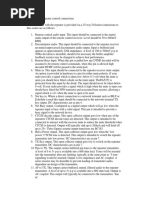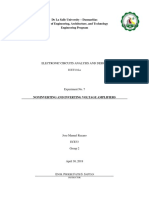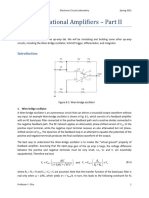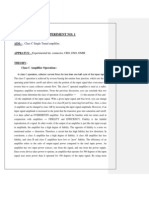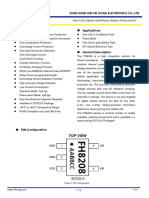100%(1)100% found this document useful (1 vote)
Experiment-14 14.1 Setting Up A Fiber Optic Analog Link Objective
Experiment-14 14.1 Setting Up A Fiber Optic Analog Link Objective
Uploaded by
Tiffany PriceThis document describes the procedure for setting up and testing a fiber optic analog link using a Link-A kit. The experiment aims to study the relationship between the input and received signals over fiber using light sources of 660nm and 950nm. The procedure involves making connections between function generator, analog buffer, transmitter, fiber, detector and oscilloscope. Input signals of varying frequency are applied and the received signals are observed to measure the analog bandwidth and response of the fiber optic link.
Copyright:
© All Rights Reserved
Available Formats
Download as DOCX, PDF, TXT or read online from Scribd
Download as docx, pdf, or txt
Experiment-14 14.1 Setting Up A Fiber Optic Analog Link Objective
Experiment-14 14.1 Setting Up A Fiber Optic Analog Link Objective
Uploaded by
Tiffany Price100%(1)100% found this document useful (1 vote)
This document describes the procedure for setting up and testing a fiber optic analog link using a Link-A kit. The experiment aims to study the relationship between the input and received signals over fiber using light sources of 660nm and 950nm. The procedure involves making connections between function generator, analog buffer, transmitter, fiber, detector and oscilloscope. Input signals of varying frequency are applied and the received signals are observed to measure the analog bandwidth and response of the fiber optic link.
Original Description:
how to make analog link
Original Title
Analog Link
Copyright
© © All Rights Reserved
Available Formats
DOCX, PDF, TXT or read online from Scribd
Share this document
Did you find this document useful?
Is this content inappropriate?
This document describes the procedure for setting up and testing a fiber optic analog link using a Link-A kit. The experiment aims to study the relationship between the input and received signals over fiber using light sources of 660nm and 950nm. The procedure involves making connections between function generator, analog buffer, transmitter, fiber, detector and oscilloscope. Input signals of varying frequency are applied and the received signals are observed to measure the analog bandwidth and response of the fiber optic link.
Copyright:
© All Rights Reserved
Available Formats
Download as DOCX, PDF, TXT or read online from Scribd
Download as docx, pdf, or txt
100%(1)100% found this document useful (1 vote)
Experiment-14 14.1 Setting Up A Fiber Optic Analog Link Objective
Experiment-14 14.1 Setting Up A Fiber Optic Analog Link Objective
Uploaded by
Tiffany PriceThis document describes the procedure for setting up and testing a fiber optic analog link using a Link-A kit. The experiment aims to study the relationship between the input and received signals over fiber using light sources of 660nm and 950nm. The procedure involves making connections between function generator, analog buffer, transmitter, fiber, detector and oscilloscope. Input signals of varying frequency are applied and the received signals are observed to measure the analog bandwidth and response of the fiber optic link.
Copyright:
© All Rights Reserved
Available Formats
Download as DOCX, PDF, TXT or read online from Scribd
Download as docx, pdf, or txt
You are on page 1/ 3
EXPERIMENT-14 14.
1 SETTING UP A FIBER OPTIC ANALOG LINK OBJECTIVE:
The objective of this experiment is to study an 660 nm/ 950 nm Fiber Optic Analog Link. In this
experiment you will study the relationship between the input signal & received signal.
EQUIPMENTS:
Link-A kit.
20 MHz Dual Channel Oscilloscope.
1 Meter Fiber cable.
Power supply.
Fig 14.1 Block Diagram to set up Analog Link PROCEDURE:
Make the connections and Jumper settings as shown in block diagram Connect the power supply
cables with proper polarity to kit. While connecting this, ensure that the power supply is OFF.
Keep all the switch faults in OFF position.
Switch on the power supply.
Select the frequency range of Function Generator with the help of Range Selection Switch SW1,
frequency can be varied with Pot P2. Adjust the voltage LEVEL of the Sine Wave with Pot P1 as per
following setting. FREQUENCY: 1KHz, LEVEL: 2Vp-p.
Connect SINE post of the Function Generator section to IN post of Analog Buffer Section. Keep
Jumpers JP2 & JP4 towards +12V position, JP3 towards sine position, JP5 towards TX1 position,
JP6 towards TX1 position & JP7 shorted.
Keep switch S3 towards TX IN position.
Connect OUT post of the Analog Buffer Section to TX IN post of TRANSMITTER.
Slightly unscrew the cap of LED SFH 756V TX1 (660 nm) from kit. Do not remove the cap from the
connector. Once the cap is loosened, insert the fiber into the cap and assure that the fiber is properly
fixed. Now tight the cap by screwing it back. Keep INTENSITY pot P3 at minimum position i.e.
fully anticlockwise.
Connect the other end of the fiber to detector SFH 250V (RX 1) in kit very carefully.
Check the output signal of the Analog Buffer at its OUT post in Kit. It should be same as that of the
applied input signal.
Observe the output signal from the detector at ANALOG OUT post on CRO by adjusting
INTENSITY (Optical Power Control) Pot P3 in kit and you should get the reproduction of the
original transmitted signal.
To measure the analog bandwidth of the link, connect the external Signal Generator with 2Vp-p sine
wave to IN post of Analog Buffer Section and vary the frequency of the input signal from 100 Hz
onwards. Measure the amplitude of the received signal for each frequency reading.
Plot a graph of gain / Frequency. Measure the frequency range for which the response is flat.
Keep Jumpers JP5 & JP6 towards TX2 position.
Remove Fiber from TX1. Slightly unscrew the cap of LED SFH 450V TX2 (950 nm) from kit. Do
not remove the cap from the connector. Once the cap is loosened, insert the fiber into the cap and
assure that the fiber is properly fixed. Now tight the cap by screwing it backs. Keep INTENSITY pot
P3 at minimum position i.e. fully anti clockwise.
Check the output signal of the Analog Buffer at its OUT post in Kit. It should be same as that of the
applied input signal.
Observe the output signal from the detector at ANALOG OUT post on CRO by adjusting
INTENSITY (Optical Power Control) Pot P3 in kit and you should get the reproduction of the
original transmitted signal.
To measure the analog bandwidth of the link, connect the external Signal Generator with 2Vp-p sine
wave to IN post of Analog Buffer Section and vary the frequency of the input signal from 100Hz
onwards. Measure the amplitude of the received signal for each frequency reading.
Plot a graph of gain / Frequency. Measure the frequency range for which the response is flat.
Fig 14.2 Expected Analog input and Output waveforms
You might also like
- Neve Technical Manual 5315-12-P Standard Broadcast Console100% (1)Neve Technical Manual 5315-12-P Standard Broadcast Console164 pages
- DC Lab 2 - Verification of Kirchhoff's Voltage Law (KVL) and Kirchhoff's Current Law (KCL)71% (24)DC Lab 2 - Verification of Kirchhoff's Voltage Law (KVL) and Kirchhoff's Current Law (KCL)3 pages
- Microwave Lab Manual - Fibre Optical Link Set UpNo ratings yetMicrowave Lab Manual - Fibre Optical Link Set Up4 pages
- Practical No. Date:: Transmitter: Fiber Optics Transmitters Are Typically Composed of A BufferNo ratings yetPractical No. Date:: Transmitter: Fiber Optics Transmitters Are Typically Composed of A Buffer41 pages
- Experiment No.6: Title: Aim: Equipment: Antenna Trainer KitNo ratings yetExperiment No.6: Title: Aim: Equipment: Antenna Trainer Kit4 pages
- Experiment Number 7 Phase Locked Loop (PLL) : The Lock RangeNo ratings yetExperiment Number 7 Phase Locked Loop (PLL) : The Lock Range4 pages
- Pre-Lab Report - 1: Exercise 1: Analog Data Transmission ObjectiveNo ratings yetPre-Lab Report - 1: Exercise 1: Analog Data Transmission Objective8 pages
- Laporan Lengkap - Am TX-RX Firdha KalsumNo ratings yetLaporan Lengkap - Am TX-RX Firdha Kalsum68 pages
- G1SLE Mk2+RevA Repeater Control ConnectionsNo ratings yetG1SLE Mk2+RevA Repeater Control Connections2 pages
- De La Salle University - Dasmariñas College of Engineering, Architecture, and Technology Engineering ProgramNo ratings yetDe La Salle University - Dasmariñas College of Engineering, Architecture, and Technology Engineering Program8 pages
- Activity: The Clapp Oscillator: ObjectiveNo ratings yetActivity: The Clapp Oscillator: Objective5 pages
- Implementation of Frequency Demodulator Using The PLL Demodulation MethodNo ratings yetImplementation of Frequency Demodulator Using The PLL Demodulation Method4 pages
- Experiment No. 03 Experiment Name-PSK Modulation AIM Equipments RequiredNo ratings yetExperiment No. 03 Experiment Name-PSK Modulation AIM Equipments Required8 pages
- Op-Amps: Experiment Guide: Part 1: Noninverting Amplifier (A) DC MeasurementsNo ratings yetOp-Amps: Experiment Guide: Part 1: Noninverting Amplifier (A) DC Measurements4 pages
- Wein Bridge Oscillator: f =1/2π√R1C1R2C2No ratings yetWein Bridge Oscillator: f =1/2π√R1C1R2C211 pages
- Reference Guide To Useful Electronic Circuits And Circuit Design Techniques - Part 2From EverandReference Guide To Useful Electronic Circuits And Circuit Design Techniques - Part 2No ratings yet
- Reference Guide To Useful Electronic Circuits And Circuit Design Techniques - Part 1From EverandReference Guide To Useful Electronic Circuits And Circuit Design Techniques - Part 12.5/5 (3)
- General Awareness and Sci & Tech (RRBJE-CBT2) 2024 SampleNo ratings yetGeneral Awareness and Sci & Tech (RRBJE-CBT2) 2024 Sample30 pages
- NCERT Solutions For Class 7 Geography Freehomedelivery - Net CH 1 5No ratings yetNCERT Solutions For Class 7 Geography Freehomedelivery - Net CH 1 523 pages
- June - 2017 Daily Vocab The Hindu EditorialNo ratings yetJune - 2017 Daily Vocab The Hindu Editorial25 pages
- RSA Public Key Cryptosystem: Rivest, Shamir, Adleman)No ratings yetRSA Public Key Cryptosystem: Rivest, Shamir, Adleman)8 pages
- Banking GK and Current Affairs For Your InterviewNo ratings yetBanking GK and Current Affairs For Your Interview31 pages
- Image Encryption and Decryption Using Symmetric Key in MatlabNo ratings yetImage Encryption and Decryption Using Symmetric Key in Matlab4 pages
- Scalability of A Mobile Agents Based Network Management ApplicationNo ratings yetScalability of A Mobile Agents Based Network Management Application8 pages
- UGC NET Electronic Science Paper II Jun 05No ratings yetUGC NET Electronic Science Paper II Jun 0512 pages
- E Book For General Knowledge Notes For SSC CGL100% (1)E Book For General Knowledge Notes For SSC CGL70 pages
- Types of Overcurrent Relays and Their ApplicationNo ratings yetTypes of Overcurrent Relays and Their Application3 pages
- Investigation of A New Idea For Antipodal Vivaldi Antenna DesignNo ratings yetInvestigation of A New Idea For Antipodal Vivaldi Antenna Design5 pages
- Undamentals of Ircuits: I VR V I V I V I V INo ratings yetUndamentals of Ircuits: I VR V I V I V I V I36 pages
- Astable Multi Vibrator: Prior To The Lab Session100% (1)Astable Multi Vibrator: Prior To The Lab Session5 pages
- UPRVUNL Di - Electric Floor Insulation Technical Specs For FGD Control RoomNo ratings yetUPRVUNL Di - Electric Floor Insulation Technical Specs For FGD Control Room2 pages
- Harbor Freight 14 Function Professional Digital Multimeter With Sound Level and Luminosity Product Manual 723998No ratings yetHarbor Freight 14 Function Professional Digital Multimeter With Sound Level and Luminosity Product Manual 72399827 pages
- Cambridge International AS & A Level: PHYSICS 9702/42No ratings yetCambridge International AS & A Level: PHYSICS 9702/4228 pages
- Module 1 - Basic Electronic Components and Its FunctionNo ratings yetModule 1 - Basic Electronic Components and Its Function20 pages
- Black Nickel Electrodeposition From A Modified Watts Bath PDFNo ratings yetBlack Nickel Electrodeposition From A Modified Watts Bath PDF7 pages
- Introduction To PCB Flipflop ConstructionNo ratings yetIntroduction To PCB Flipflop Construction10 pages


























